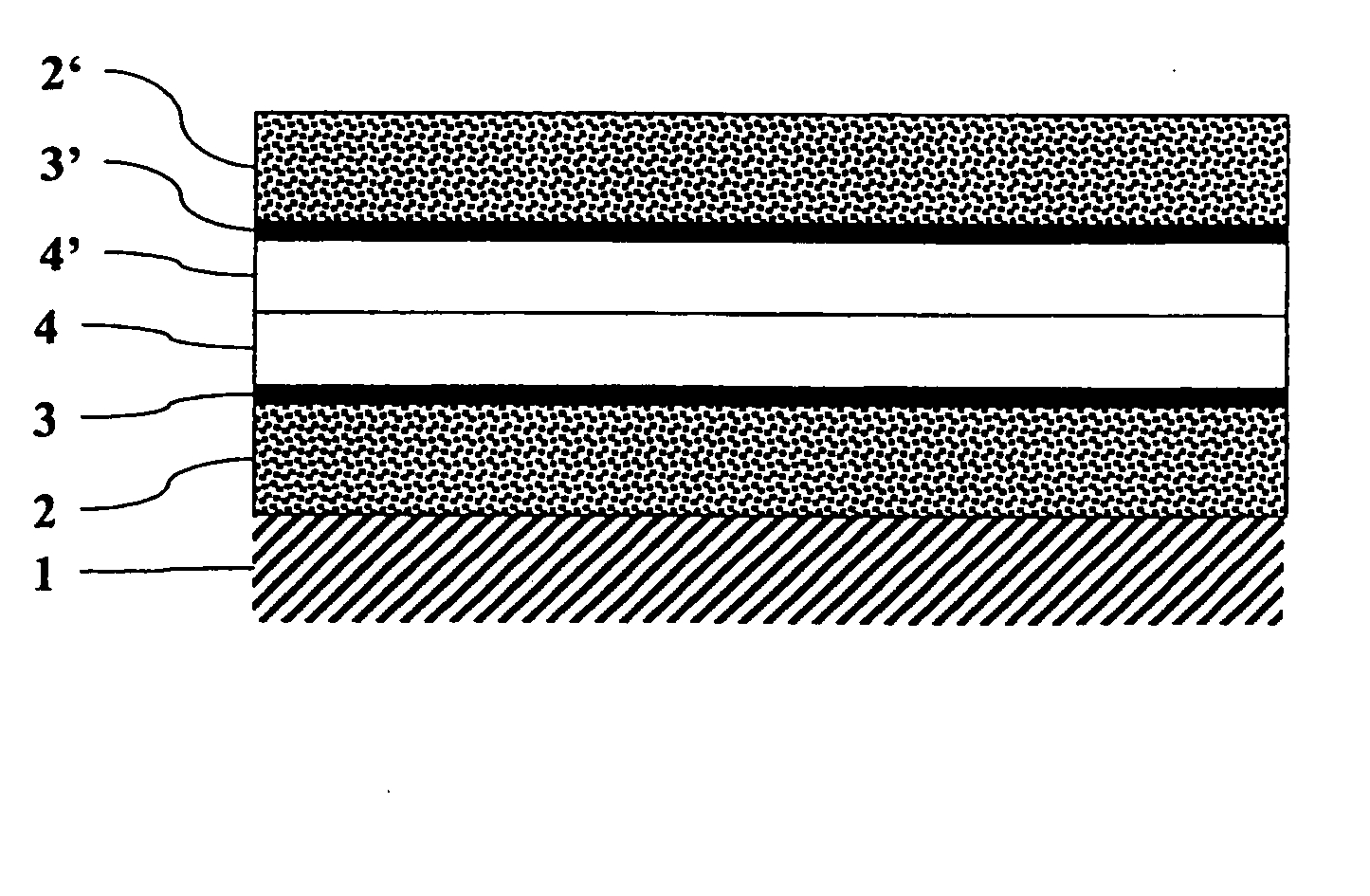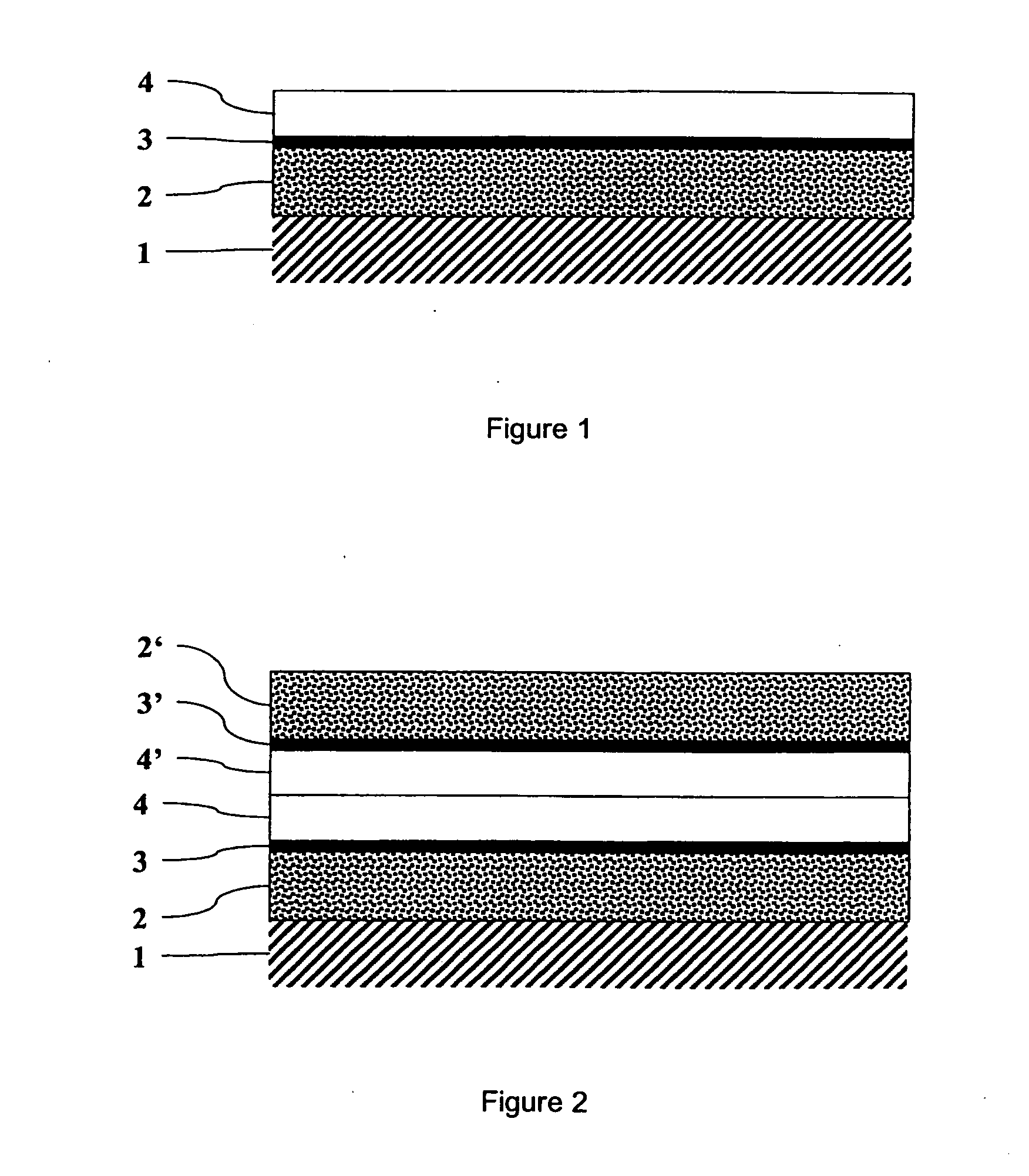Flexible materials for optical applications
a flexible material and optical technology, applied in the field of flexible materials for optical applications, can solve the problems of limited number of possible combinations of layers, porous layers, brittle inorganic layers mentioned above, etc., and achieve the effect of high mechanical flexibility
- Summary
- Abstract
- Description
- Claims
- Application Information
AI Technical Summary
Benefits of technology
Problems solved by technology
Method used
Image
Examples
example 1
[0143]A porous or nanoporous layer having a low refractive index and having the composition (in the dry state) as listed in Table 2 was applied to a subbed transparent polyester film Cronar® 742, available from DuPont Teijin Films, Luxemburg.
TABLE 2IngredientQuantity (g / m2)Surface modified SiO26.000Polyvinyl alcohol C1.300Cross-linking agent0.229
[0144]The surface modified SiO2 was prepared according to the method of example 1 of patent application EP 1,655,348.
[0145]Polyvinyl alcohol C is available as Mowiol 40-88 from Omya AG, Oftringen, Switzerland. The cross-linking agent is boric acid, available from Schweizerhall Chemie AG, Basel, Switzerland.
[0146]A non-porous layer with a thickness of about 0.24 μm having a high refractive index and consisting of polyvinyl alcohol B was applied onto this porous or nanoporous layer having a low refractive index.
[0147]Polyvinyl alcohol B is available as Mowiol 56-98 from Omya AG, Oftringen, Switzerland.
example 2
[0148]A porous or nanoporous layer having a low refractive index and having the composition (in the dry state) as listed in Table 3 was applied to the subbed transparent polyester film of Example 1.
TABLE 3IngredientQuantity (g / m2)Surface modified SiO221.052Polyvinyl alcohol C4.928Cross-linking agent0.800
[0149]A non-porous layer having a high refractive index and having the composition (in the dry state) as listed in Table 4 was applied onto this porous or nanoporous layer having a low refractive index.
TABLE 4IngredientQuantity (g / m2)Polyvinyl alcohol D0.070Latex0.930
[0150]Polyvinyl alcohol D is available as Gohsefimer K-210 from Nippon Synthetic Chemical Industry Ltd., Osaka, Japan. The latex is Jonrez E2001, available from MeadWestvaco Corporation, Stamford, USA.
[0151]This layer was sealed at a temperature of 120° C. at a speed of about 27 cm / min with a laminator GBC 3500.
example 3
[0152]A porous or nanoporous layer having a low refractive index and having the composition (in the dry state) as listed in Table 5 was applied to the subbed transparent polyester film of Example 1.
TABLE 5IngredientQuantity (g / m2)Aluminium oxide / hydroxide containing20.250lanthanumLactic acid0.369Polyvinyl alcohol A0.785Polyvinyl alcohol B1.830Cross-linking agent0.021
[0153]The aluminum oxide / hydroxide was prepared according to the method of Example 1 of patent application EP 0,967,086.
[0154]A non-porous layer having a high refractive index and having the composition (in the dry state) as listed in Table 6 was applied onto this porous or nanoporous layer having a low refractive index.
TABLE 6IngredientQuantity (g / m2)Polyvinyl pyrrolidone0.500Cross-linking agent0.250
[0155]Polyvinyl pyrrolidone is available as Luviskol K90 from BASF AG, Wädenswil, Switzerland.
Test Methods
[0156]The flexible material for optical applications according to the invention show well visible interference colors ...
PUM
| Property | Measurement | Unit |
|---|---|---|
| Thickness | aaaaa | aaaaa |
| Thickness | aaaaa | aaaaa |
| Thickness | aaaaa | aaaaa |
Abstract
Description
Claims
Application Information
 Login to View More
Login to View More - R&D
- Intellectual Property
- Life Sciences
- Materials
- Tech Scout
- Unparalleled Data Quality
- Higher Quality Content
- 60% Fewer Hallucinations
Browse by: Latest US Patents, China's latest patents, Technical Efficacy Thesaurus, Application Domain, Technology Topic, Popular Technical Reports.
© 2025 PatSnap. All rights reserved.Legal|Privacy policy|Modern Slavery Act Transparency Statement|Sitemap|About US| Contact US: help@patsnap.com


